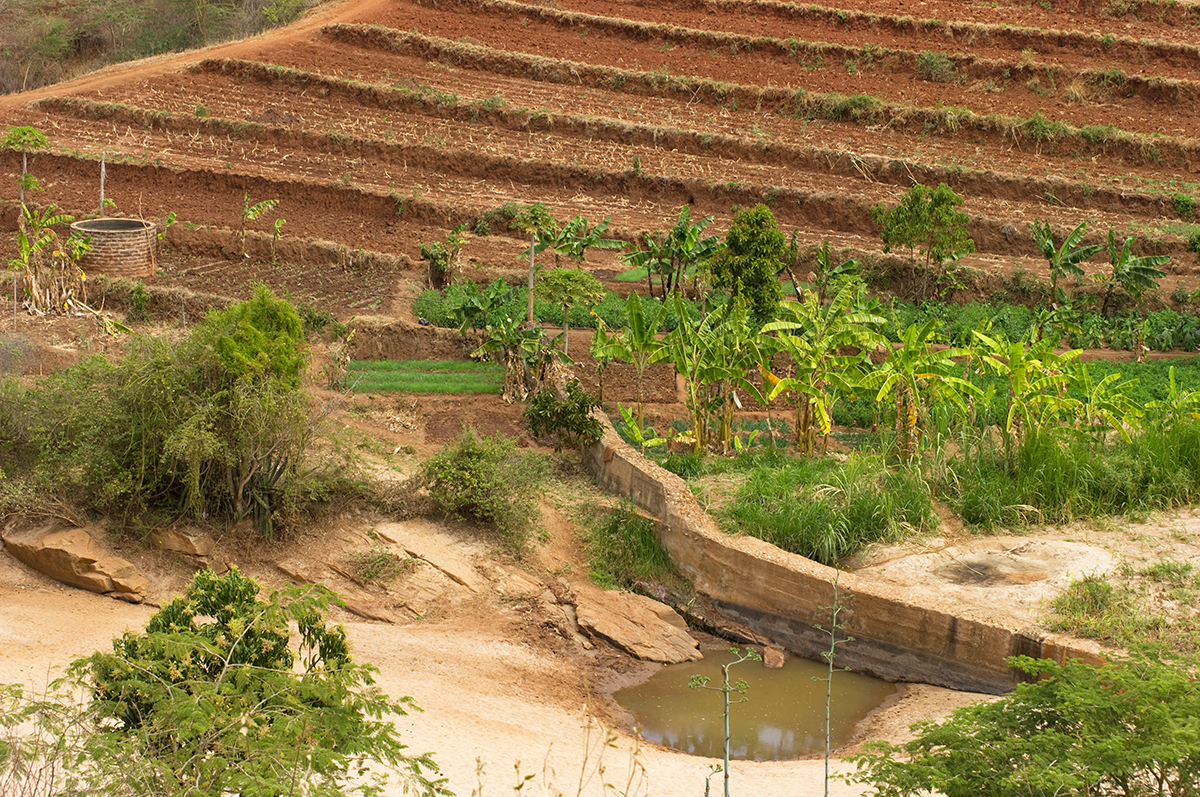Faanya Juu, throwing it upwards in Kenya
Introduction
Terrace farming on slopes helps conserve water. Along with other measures such as micro-dams, stone bunds and percolation pits, this can reduce surface runoff and increase soil moisture. One such system called Fanya juu terrace have expanded in several parts of East Africa, particularly in the Machachakos District in Kenya where 85% of the land is now terraced.
They are expanding in other areas such as the Makanya catchment in northern Tanzania. This catchment of 300 sq km is part of the Pangani River basin. Its population still largely depends on subsistence agriculture and the area is characterized by high rainfall variability – ranging from 400 - 800 mm annually. There are two rainy seasons: the long one (masika) that lasts from March till May, and the shorter season (vuli) from October to December.
The maximum rainfall for either season is 400 mm. With the amount of water often heavily constrained, conservation measures are of crucial importance to raise yields and provide food security.
Conservation measures in Makanya include hand-hoeing, terracing, intercropping, small flow diversions and irrigation from micro-dams.
Fanya juu: to throw it upward
The terrace systems are created by excavating a trench along the slope and applying the excavated soil material immediately uphill of the trench. This is repeated several times along a slope and as a result a system of benches and trenches is created. The purpose of this system is to catch the flow of soil and rain water in the trenches and allow it to percolate. Fanya juu literally means ‘throw it upwards’ in Kiswahili.
The trenches can be developed on areas with slopes between 5 to 60% and climates like Makanya. As slopes get steeper the fanya juus become more costly to make. The spacing of the trenches and bunds depends on slope and soil depth. On land with less than 5% slope it is 20-30 m, but terraces get smaller as land gets steeper: 15-20 m on land with a 5-10% slope; 10 to 15 m on a slope of 10% or more; and 5 m on even steeper slopes (10% or more). The height interval between two terraces is 1.7 m. As a rule of the thumb the distance between two terraces is 100 times the height interval between two terraces divided by the land gradient (in %). The infiltration ditches are typically 60 cm deep and 75 cm wide. The bund has a typical height of 0.4 m and a base of 0.5-1 m, and can vary to a height of 0.5 m and a base of 1.5 m.
The construction by hand takes 90 days per ha on a typical 15% slope – or more (150-350 days/ha) in areas that are prone to erosion and have unstable soils. This translates in a cost of USD 60-460 per hectare. Bunds are best stabilized with grasses, which can be used for fodder too. Annual maintenance consists of building up the bunds from below and trimming grass.
Benefits
Against the typical establishment costs of USD 60-460 per ha, fanya juu avoid uncontrolled run-off and improve the retention of soil moisture. This makes it possible to have earlier planting dates and a prolonged farming season, enabling higher yields of existing crops and providing opportunities for farmers to introduce new crops and new varieties. The fanya juu also help over dry spells. Crop yields typically increase by 50%.
Moreover, along the trenches horticulture crops can be grown: papaya, banana and fodder. Fanya juu protect against erosion and have the lowest soil loss of all soil water conservation systems. In a study of Kwalei, Tanzania soil loss from these systems was estimated at 2.7 ton/ha for the two seasons. In comparison to areas without protection, annual soil loss was estimated at 25 ton/ha, in grass strip areas it was estimated at 15 ton/ha, and for bench terraces 6 ton/ha. Fanya juu are economic investments in agricultural production – particularly when the land is not too steep or unstable.
Research found that moisture levels in the rootzone around the fanya juu bench and trench structures were higher than those located at a distance. In the beginning of the rainy seasons, specifically, for the gentle-sloped areas (with large distances between the bunds) the moisture content around the fanya juu structure was around 17% and 12% in the area in the middle of the structures and upstream of those. In the dry spells the moisture level around the fanya juu structure was 3% higher than the other sites.
Soil moisture was lower in the steeper slopes. The distribution of moisture is critical as crops may move into the moisture-stressed conditions in parts of the fields. For moisture optimization the distance between fanya juu structures needs to be smaller (smaller than the distance recommended for the purpose of soil conservation) in order to enlarge the hydraulic potential of these structures. On steep slopes, particularly with shallow soils, the water of the trenches drains more as sublateral flows rather than adding moisture to the root zone.
Another major conclusion is that in both sites with the fanya juu structures more than 50% of the water captured does not benefit local use as it is lost to deep percolation. This loss leaves room for other local water conservation structures, like micro-dams, to improve water retention in the area.
(Excerpted from Transforming landscapes, transforming lives : the business of sustainable water buffer management).





Trending Discussions
From around the site...
“Absolutely interested! I'll connect via email to discuss reviewing and enhancing the Economic Analysis of Climate...”
Adaptation-related events at COP28 (all available to follow/stream online)
“Please check out these adaptation-related events taking place at COP28 - all available online (some in person too if...”
Shining a light for biodiversity – four perspectives to the life that sustains us. Four hybrid sessions.
“30 November to 19 December 2023 - Four Sessions Introduction The SDC Cluster Green is happy to invite you to the...”